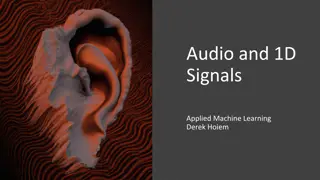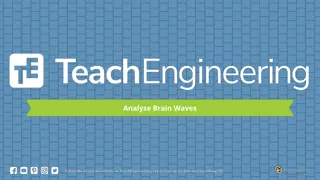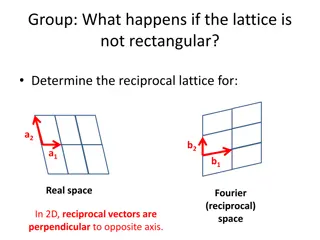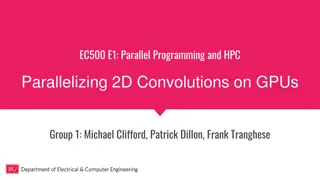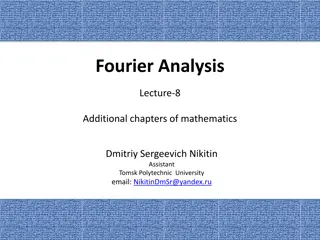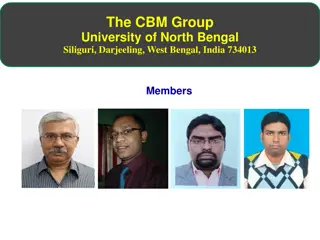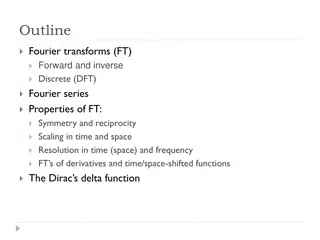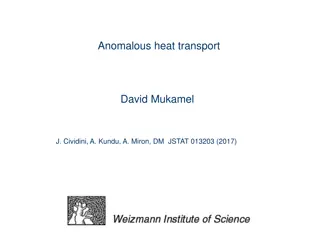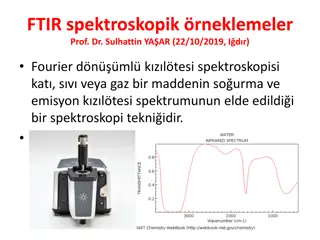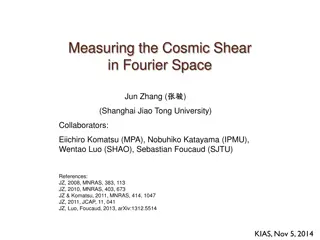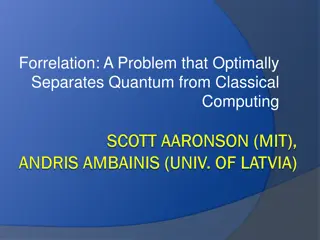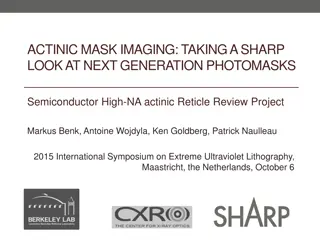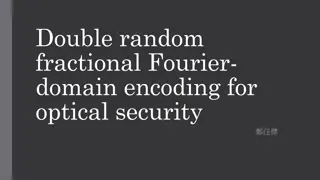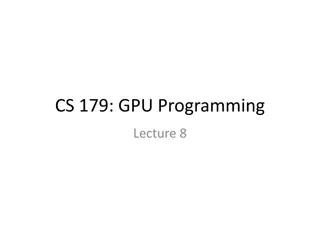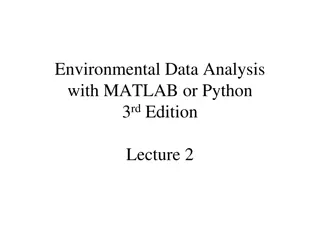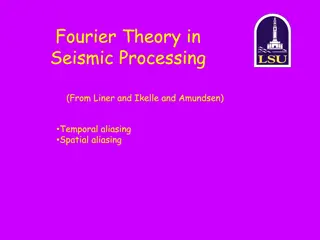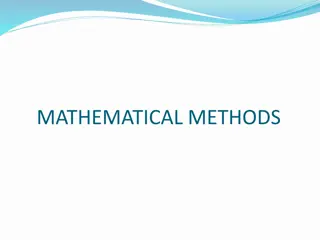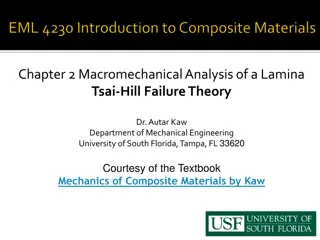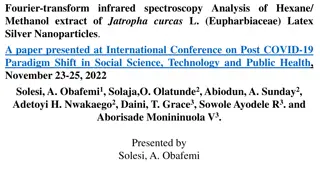Understanding Audio and 1D Signals in Machine Learning
Explore the world of audio and 1D signals in machine learning through topics such as representing sound with frequencies, deep networks for audio analysis, and the common use cases of 1D time series data. Learn about signal analysis, frequency spectra, and the contributions of Jean Baptiste Joseph F
6 views • 40 slides
Exploring Brain Waves Through EEG Analysis
Delve into the world of brain waves with EEG, EKG, and EMG measurements. Learn how to analyze brain wave data using mathematical processes like Fast Fourier Transform (FFT) and Power Spectral Density (PSD). Discover the significance of different frequencies in brain wave signals and how they reflect
1 views • 13 slides
Evolution of Mathematical Theories and Proof Systems
Development of mathematical theories such as model theory, proof theory, set theory, recursion theory, and computational complexity is discussed, starting from historical perspectives with Dedekind and Peano to Godel's theorems, recursion theory's golden age in the 1930s, and advancements in proof t
1 views • 29 slides
Psychological Theories of Criminality: Understanding the Roots
Psychological theories of criminality delve into the association between intelligence, personality, learning, and criminal behavior. Major theories include Psychodynamic Theory by Freud, Behavioral Theory by Bandura, and Cognitive Theory by Kohlberg. These theories explore how unconscious mental pro
1 views • 20 slides
Understanding Heat Transfer: Conduction, Thermal Conductivity, and More
Explore the fundamentals of heat transfer through conduction and thermal conductivity as explained by Dr. J. Badshah. Learn about the modes of heat transfer, Fourier's law, thermal resistance, and the relationship between thermal and electrical conductivity. Discover the essential features of therma
1 views • 9 slides
Understanding the Theory of Firms: Neoclassical vs. Modern Approaches
The theory of firms is explored through the Neoclassical and Modern perspectives. Neoclassical theory focuses on profit maximization, while Modern theory delves into managerial, principal-agent, and transaction cost theories. The discussion covers criticisms of Neoclassical theory and the essential
1 views • 79 slides
Understanding Reciprocal Lattices in Crystal Structures
Explore the concept of reciprocal lattices in crystal structures, including non-rectangular lattices, Fourier space in 2D, Wigner-Seitz cells, Brillouin Zones, and the relationship between BCC and FCC structures. Learn about primitive lattice vectors, construction of the Brillouin Zone, and the sign
0 views • 49 slides
Exploring GPU Parallelization for 2D Convolution Optimization
Our project focuses on enhancing the efficiency of 2D convolutions by implementing parallelization with GPUs. We delve into the significance of convolutions, strategies for parallelization, challenges faced, and the outcomes achieved. Through comparing direct convolution to Fast Fourier Transform (F
0 views • 29 slides
Theories of Causation in Psychological and Social Sciences
Overview of theories of causation categorized into psychological, social psychological, and sociological perspectives. Psychological theories focus on instinctive, biological, and psychological qualities of abusers, including Attachment Theory, Psychodynamic Theory, Social Learning Theory, and Situa
0 views • 15 slides
Understanding Political Theory through a Contextual Approach
Exploring G.H. Sabine's perspective on political theory through a contextual approach, emphasizing the importance of historical context and societal influences. Sabine argues that while political theory evolves with its contemporary politics, it should be analyzed within its specific time and social
0 views • 9 slides
Understanding Fourier Analysis and Its Applications
Fourier analysis is essential in representing periodic functions using Fourier series, allowing for solving differential equations and approximating complex functions. The method extends to nonperiodic phenomena through Fourier integrals and transforms, with significant applications in engineering a
0 views • 21 slides
Study on Collective Flow and Participant Eccentricity in High-energy Heavy-ion Collisions
Explore the research on collective behavior, eccentricity, and flow of final state particles in high-energy heavy-ion collisions. Learn about the measurement of Fourier coefficients, azimuthal angles, and spatial anisotropy, as well as the analysis of system size dependence and radial flow in variou
1 views • 29 slides
Evolution of Light Theory: From Wave Theory to Quantum Theory
At the turn of the century, the discovery of the photoelectric effect challenged the wave theory of light, leading to the development of the quantum theory by Max Planck and Albert Einstein. This new theory introduced the concept of discrete energy units known as quanta, bridging the gap between wav
1 views • 62 slides
Comprehensive Overview of Freezing Time Methods in Dairy Engineering
Neumann, Tao, and Non-Dimensional methods are key approaches for determining freezing times in unsteady state heat transfer processes in dairy engineering. The Neumann Problem, Tao Solutions, and Cleland and Earle Non-Dimensional Equation offer distinct equations and models to calculate freezing tim
1 views • 8 slides
Dp-branes, NS5-branes, U-duality, and M-Theory Overview
Overview of Dp-branes, NS5-branes, and U-duality derived from nonabelian (2,0) theory with Lie 3-algebra. Introduction to M-theory, including M2-branes and M5-branes in the strong coupling limit. Discussion on BLG theory, Lorentzian Lie 3-algebra, and the ABJM theory for M2-branes.
1 views • 32 slides
Understanding Sampling and Signal Processing Fundamentals
Sampling plays a crucial role in converting continuous-time signals into discrete-time signals for processing. This lecture covers periodic sampling, ideal sampling, Fourier transforms, Nyquist-Shannon sampling, and the processing of band-limited signals. It delves into the relationship between peri
1 views • 60 slides
Applications of Time-Frequency Analysis for Filter Design
Signal decomposition and filter design techniques are explored using time-frequency analysis. Signals can be decomposed in both time and frequency domains to extract desired components or remove noise. Various transform methods like the Fourier transform and fractional Fourier transform are employed
1 views • 35 slides
Understanding Fourier Transforms and Properties
Fourier transforms play a crucial role in signal processing by transforming signals between time and frequency domains. This outline covers the basics of Fourier transforms, discrete Fourier transforms, Fourier series, properties like symmetry and reciprocity, resolution in time and frequency, the D
0 views • 5 slides
Carnegie Mellon Algebraic Signal Processing Theory Overview
Carnegie Mellon University is at the forefront of Algebraic Signal Processing Theory, focusing on linear signal processing in the discrete domain. Their research covers concepts such as z-transform, C-transform, Fourier transform, and various signal models and filters. The key concept lies in the al
2 views • 40 slides
Understanding Time-Independent Perturbation Theory in Quantum Mechanics
Perturbation theory is a powerful tool in solving complex physical and mathematical problems approximately by adjusting solutions from a related problem with known solutions. This theory allows for more accurate approximate solutions by treating the difference as a small perturbation. An example inv
0 views • 19 slides
Ethical Theories: Divine Command vs. Virtue Theory Explained
Divine Command Theory asserts that morality is derived from God's commands, contrasting with Virtue Theory which focuses on developing moral virtues to achieve human flourishing and excellence. Divine Command Theory relies on religious texts, while Virtue Theory emphasizes the cultivation of virtues
0 views • 24 slides
Understanding Fermi Liquid Theory in Interacting Fermion Systems
Fermi liquid theory, also known as Landau-Fermi liquid theory, is a theoretical model that describes the normal state of metals at low temperatures. Introduced by Landau and further developed by Abrikosov and Khalatnikov, this theory explains the similarities and differences between interacting ferm
0 views • 23 slides
Anomalous Heat Transport in Mathematical Physics
Anomalous heat transport deviates from standard Fourier law, exhibiting divergent heat conductance and non-trivial temperature profiles. Observations include long-range time correlations and divergent temperature gradients at boundaries. Models like coupled oscillators and hard disks with alternatin
0 views • 43 slides
Fourier Transform Infrared (FTIR) Spectroscopy Examples by Prof. Dr. Sulhattin YAŞAR
Fourier Transform Infrared (FTIR) spectroscopy is a technique used to obtain the absorption and emission spectra of solid, liquid, or gas substances. This content provides characteristic absorption peaks for various functional groups, such as alkane, alkyl, alkenyl, alkynyl, aromatic compounds, alco
0 views • 15 slides
Cosmic Shear Measurement in Fourier Space and Its Scientific Goals
Exploring the cosmic shear in Fourier space with a collaborative effort led by Jun Zhang from Shanghai Jiao Tong University sheds light on fundamental scientific questions related to dark energy, the geometry of the universe, General Relativity, cold dark matter, and cosmic structure density distrib
0 views • 48 slides
Quantum vs. Classical Computing: Exploring Forrelation Problem
Delve into the world of quantum and classical computing with the Forrelation problem that optimally separates the two realms. From Fourier correlations to quantum algorithms and classical lower bounds, explore the intricacies of distinguishing between quantum and classical computation through variou
0 views • 29 slides
Advanced Microscopy Techniques in EUV Lithography: SHARP Overview
SHARP utilizes Fresnel zone plate lenses to achieve diffraction-limited quality in EUV lithography, offering a range of NA values and image magnifications. The system allows emulation of mask-side imaging conditions with hundreds of lenses available. Coherence control and engineering are provided th
1 views • 18 slides
Next-Generation Photomasks in Extreme Ultraviolet Lithography Symposium
Explore the latest advancements in actinic mask imaging and semiconductor high-NA reticle technology presented at the 2015 International Symposium on Extreme Ultraviolet Lithography in Maastricht. Topics include zoneplate lenses, phase reconstruction algorithms, Fourier Ptychography microscopy, and
0 views • 56 slides
Computational Learning Theory: An Overview
Computational Learning Theory explores inductive learning algorithms that generate hypotheses from training sets, emphasizing the uncertainty of generalization. The theory introduces probabilities to measure correctness and certainty, addressing challenges in learning hidden concepts. Through exampl
0 views • 43 slides
Optical Security with Double Random Fractional Fourier Domain Encoding
Utilizing double random fractional Fourier domain encoding for optical security involves encryption and decryption methods based on the fractional Fourier transform of various orders, involving specific mathematical operations and notations. The process includes transforming the input function, encr
0 views • 13 slides
Automata Theory and Theory of Computation Overview
This course overview covers concepts in automata theory and theory of computation, including formal language classes, grammars, recognizers, theorems in automata theory, decidability, and intractability of computational problems. The Chomsky hierarchy, interplay between computing components, modern-
0 views • 42 slides
Theories of Interest in Microeconomics II
Explore various theories of interest in economics, including the Classical Theory, Liquidity Preference Theory by Keynes, Productivity Theory, Abstinence Theory, Time-Preference Theory, Fisher's Time Preference Theory, and the Loanable Fund Theory. These theories offer different perspectives on the
0 views • 6 slides
Exploring the Evolution of Atomic Theory
Delve into the historical journey of atomic theory starting from Democritus and Aristotle's views to modern advancements proving some aspects of Dalton's theory incorrect. Learn about key laws and theories such as the Particle Theory of Matter, Dalton's Atomic Theory, and JJ Thomson's discoveries, s
0 views • 30 slides
Understanding GPU-Accelerated Fast Fourier Transform
Today's lecture delves into the realm of GPU-accelerated Fast Fourier Transform (cuFFT), exploring the frequency content present in signals, Discrete Fourier Transform (DFT) formulations, roots of unity, and an alternative approach for DFT calculation. The lecture showcases the efficiency of GPU-bas
0 views • 40 slides
Environmental Data Analysis with MATLAB or Python 3rd Edition Lecture 2
Learn about data analysis using MATLAB or Python, covering topics such as probability, linear models, Fourier series, filter theory, factor analysis, hypothesis testing, and more. Explore tools for analyzing data and work with temperature data from the Black Rock Forest. Get hands-on experience in u
0 views • 39 slides
Understanding Fourier Theory in Seismic Processing
Fourier theory plays a crucial role in seismic processing by helping to avoid temporal and spatial aliasing. It emphasizes the importance of sampling rates for accurate waveform reconstruction and highlights the significance of oversampling to prevent aliasing issues. Spatial aliasing is discussed i
0 views • 18 slides
Comprehensive Overview of Mathematical Methods and Resources
Covering topics such as interpolation, curve fitting, algebraic equations, transcendental equations, numerical differentiation, integration, Fourier series, Fourier transforms, partial differential equations, vector calculus, and finite difference methods. Includes recommended textbooks and referenc
0 views • 150 slides
Macromechanical Analysis of Lamina and Tsai-Hill Failure Theory Overview
The Tsai-Hill failure theory is based on the strengths of a unidirectional lamina, incorporating longitudinal and transverse tensile and compressive strengths, as well as in-plane shear strength. This theory, derived from the distortion energy theory, provides criteria for determining lamina failure
0 views • 15 slides
Fourier-transform Infrared Spectroscopy Analysis of Jatropha curcas Latex Silver Nanoparticles
Utilizing Fourier-transform infrared spectroscopy, this paper discusses the analysis of hexane/methanol extracts of Jatropha curcas latex silver nanoparticles. The study explores the biosynthesis of nanoparticles using plant secondary metabolites as reducing agents, highlighting the medicinal proper
0 views • 15 slides
Understanding Fast Fourier Transform (FFT) in Signal Processing
Fast Fourier Transform (FFT) is a powerful algorithm used in signal processing to efficiently calculate the Discrete Fourier Transform (DFT). This advanced technique leverages symmetry and periodicity properties to reduce computational complexity, making it a key tool in digital signal analysis. By
0 views • 14 slides
